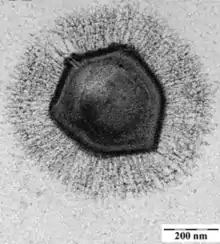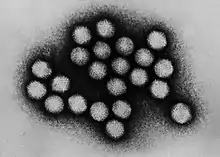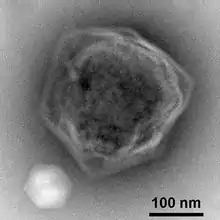Bamfordvirae
Bamfordvirae bezeichnet ein Reich von Viren.[3] Dieses Taxon ist gekennzeichnet durch Hauptkapsidproteine (englisch major capsid proteins) mit „double jelly roll“-Struktur (DJR-Viren).[4][5] Vor der offiziellen Bestätigung durch das International Committee on Taxonomy of Viruses (ICTV) war diese Gruppe als PRD1-Adenovirus-Linie bezeichnet worden.[6] Das Taxon ist nach Dennis H. Bamford benannt, der zuerst die evolutionäre Verwandtschaft aller Viren DJR-Hauptkapsidproteinen postulierte.[7][8][6]
| Bamfordvirae | ||||||
|---|---|---|---|---|---|---|

| ||||||
| Systematik | ||||||
| ||||||
| Taxonomische Merkmale | ||||||
| ||||||
| Wissenschaftlicher Name | ||||||
| Bamfordvirae | ||||||
| Kurzbezeichnung | ||||||
| DJRV | ||||||
| Links | ||||||
|
Systematik

Adenoviren im TEM

Zu den Bamfordvirae gehören derzeit (mit Stand Juni 2021) folgende vom ICTV bestätigte Phyla:[2]
- Nucleocytoviricota mit Pocken- und Riesenviren
- Preplasmiviricota mit:
- Klasse Maveriviricetes mit Familie Lavidaviridae
- Klasse Polintoviricetes mit Familie Adintoviridae
- Klasse Tectiliviricetes
- Ordnung Belfryvirales mit Familie Turriviridae
- Ordnung Kalamavirales mit Familie Tectiviridae
- Ordnung Rowavirales mit Familie Adenoviridae
- Ordnung Vinavirales mit Familie Corticoviridae
- ohne zugewiesene Ordnung: Familie Autolykiviridae[5]
Diese Systematik dokumentiert die weitläufige Verwandtschaft der Riesenviren mit ihren eigenen Virophagen aus den Lavidaviridae.
Einzelnachweise
- ICTV: ICTV Master Species List 2019.v1, New MSL including all taxa updates since the 2018b release, March 2020 (MSL #35)
- ICTV: ICTV Master Species List 2020.v1, New MSL including all taxa updates since the 2019 release, March 2021 (MSL #36)
- Virus Taxonomy: 2019 Release. In: talk.ictvonline.org. International Committee on Taxonomy of Viruses. März 2020. Abgerufen am 25. April 2020.
- Eugene V. Koonin, V. V. Dolja, M. Krupovič, A. Varsani, Y. I. Wolf, N. Yutin, M. Zerbini, J. H. Kuhn: Create a megataxonomic framework, filling all principal taxonomic ranks, for DNA viruses encoding vertical jelly roll-type major capsid proteins. In: ICTV Proposal (Taxoprop). Oktober 2019, S. 2019.003G. doi:10.13140/RG.2.2.14886.47684.
- Kathryn M. Kauffman, Fatima A. Hussain, Joy Yang, Philip Arevalo, Julia M. Brown, William K. Chang, David VanInsberghe, Joseph Elsherbini, Radhey S. Sharma, Michael B. Cutler, Libusha Kelly, Martin F. Polz: A major lineage of non-tailed dsDNA viruses as unrecognized killers of marine bacteria, in: Nature Band 554, S. 118–122, 24. Januar 2018, doi:10.1038/nature25474
- Mart Krupovič, Dennis H. Bamford: Virus evolution: how far does the double β-barrel viral lineage extend?. In: Nature Reviews Microbiology. 6, Nr. 12, Dezember 2008, S. 941–948. doi:10.1038/nrmicro2033. PMID 19008892.
- Dennis H Bamford, R. M. Burnett, D. I. Stuart: Evolution of viral structure.. In: Theoretical Population Biology. 61, Nr. 4, 2002, S. 461–470. doi:10.1006/tpbi.2002.1591. PMID 12167365.
- Dennis H. Bamford: Do viruses form lineages across different domains of life?. In: Research in Microbiology. 154, Nr. 4, 2003, S. 231–236. doi:10.1016/S0923-2508(03)00065-2. PMID 12798226.
- S. Duponchel, M. G. Fischer: "Viva lavidaviruses! Five features of virophages that parasitize giant DNA viruses". PLoS pathogens, 15(3), 2019. doi:10.1371/journal.ppat.1007592.
 Das Material Stammt von dieser Quelle, die verfügbar ist unter einer Creative Commons Attribution 4.0 International License.
Das Material Stammt von dieser Quelle, die verfügbar ist unter einer Creative Commons Attribution 4.0 International License.
This article is issued from Wikipedia. The text is licensed under Creative Commons - Attribution - Sharealike. The authors of the article are listed here. Additional terms may apply for the media files, click on images to show image meta data.